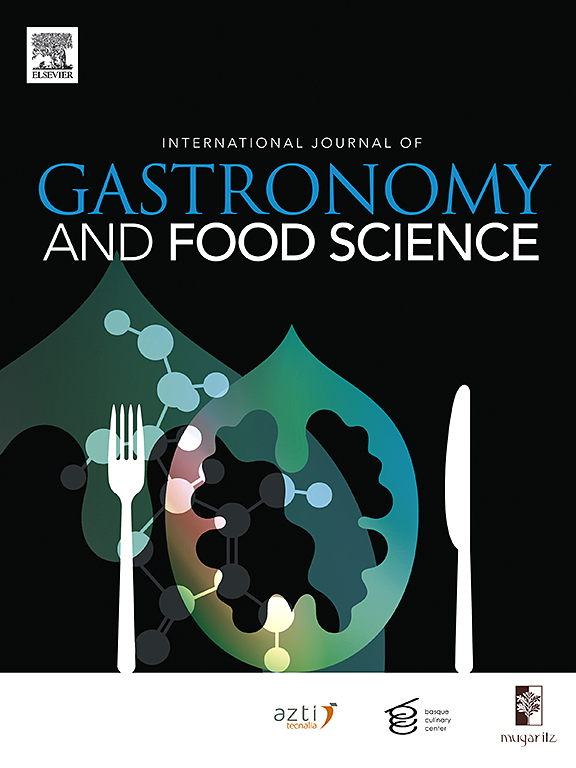The art of confectionery creams: Rheological insight across formulations
IF 3.2
2区 农林科学
Q2 FOOD SCIENCE & TECHNOLOGY
International Journal of Gastronomy and Food Science
Pub Date : 2025-06-03
DOI:10.1016/j.ijgfs.2025.101217
引用次数: 0
Abstract
Food formulations and processing methods play a fundamental role in defining the final properties of both homemade and industrially produced foods. We examines the rheological and textural properties of two popular dessert specialties, custard and pastry cream, comparing traditional recipes with industrial formulations. A commercial rotational rheometer was adapted as a rheo-reactor to simulate the cooking process, enabling real-time observation of rheo-mechanical changes. The results show that the complex viscosity (η∗) of traditional custard increases from 0.02 to 10 Pa s during heating, while industrial formulations exhibit a lower range of 0.02–0.1 Pa s, highlighting the impact of formulation on thermal behaviour. Textural analysis was conducted to characterize mechanical properties relevant to sensory perception. A comparative approach was used to evaluate two aspects: first, the impact of modifying a single ingredient in kitchen-made formulations, demonstrating how this leads to distinct structural outcomes—one yielding a fluid and creamy texture, the other forming a fragile gel. Second, a comparison between traditional and industrial formulations revealed that, despite differences in ingredients and microstructure, the final textural properties were remarkably similar. These findings provide insights into the formulation and processing strategies needed to replicate traditional textures in industrial food production.
糖果奶油的艺术:流变性洞察跨配方
食品配方和加工方法在决定自制和工业生产食品的最终特性方面起着根本作用。我们研究了两种流行的甜点特色,蛋奶冻和糕点奶油的流变学和质地特性,比较了传统配方和工业配方。采用商用旋转流变仪作为流变反应器来模拟蒸煮过程,从而实时观察流变力学变化。结果表明,传统蛋奶冻的复合粘度(η∗)在加热过程中从0.02 ~ 10 Pa s增加,而工业配方的复合粘度(η∗)在0.02 ~ 0.1 Pa s的范围内增加,突出了配方对热行为的影响。进行了纹理分析,以表征与感官知觉相关的机械性能。一种比较方法被用来评估两个方面:首先,在厨房制作的配方中修改单一成分的影响,展示了这如何导致不同的结构结果——一种产生流体和奶油质地,另一种形成易碎的凝胶。其次,对传统配方和工业配方的比较表明,尽管成分和微观结构不同,但最终的质地性能非常相似。这些发现为在工业食品生产中复制传统质地所需的配方和加工策略提供了见解。
本文章由计算机程序翻译,如有差异,请以英文原文为准。
求助全文
约1分钟内获得全文
求助全文
来源期刊

International Journal of Gastronomy and Food Science
Social Sciences-Cultural Studies
CiteScore
5.30
自引率
10.50%
发文量
170
审稿时长
45 days
期刊介绍:
International Journal of Gastronomy and Food Science is a peer-reviewed journal that explicitly focuses on the interface of food science and gastronomy. Articles focusing only on food science will not be considered. This journal equally encourages both scientists and chefs to publish original scientific papers, review articles and original culinary works. We seek articles with clear evidence of this interaction. From a scientific perspective, this publication aims to become the home for research from the whole community of food science and gastronomy.
IJGFS explores all aspects related to the growing field of the interaction of gastronomy and food science, in areas such as food chemistry, food technology and culinary techniques, food microbiology, genetics, sensory science, neuroscience, psychology, culinary concepts, culinary trends, and gastronomic experience (all the elements that contribute to the appreciation and enjoyment of the meal. Also relevant is research on science-based educational programs in gastronomy, anthropology, gastronomic history and food sociology. All these areas of knowledge are crucial to gastronomy, as they contribute to a better understanding of this broad term and its practical implications for science and society.
 求助内容:
求助内容: 应助结果提醒方式:
应助结果提醒方式:


